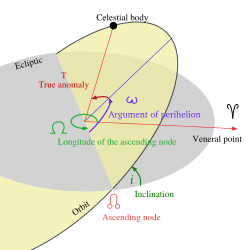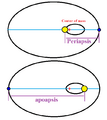Apsis facts for kids
In astronomy, an apsis (plural apsides) is the point of greatest or least distance of the elliptical orbit of an astronomical object from its center of attraction, which is generally the center of mass of the system.
The point of closest approach is called the periapsis or pericentre and the point of farthest excursion is called the apoapsis (Greek από, from, which becomes απ before a vowel, and αφ before rough breathing), apocentre or apapsis (the latter term, although etymologically more correct, is much less used). A straight line drawn through the periapsis and apoapsis is the line of apsides. This is the major axis of the ellipse, the line through the longest part of the ellipse.
Similar words are used to identify the body being orbited:
- For any satellite of Earth including the Moon the point of least distance is the perigee, and greatest distance the apogee.
- For a body orbiting the Sun, the point of least distance is the perihelion, and the point of greatest distance is the aphelion.
Images for kids
-
The two-body system of interacting elliptic orbits: The smaller, satellite body (blue) orbits the primary body (yellow); both are in elliptic orbits around their common center of mass (or barycenter), (red +). ∗Periapsis and apoapsis as distances: The smallest and largest distances between the orbiter and its host body.
See also
 In Spanish: Ápside para niños
In Spanish: Ápside para niños




